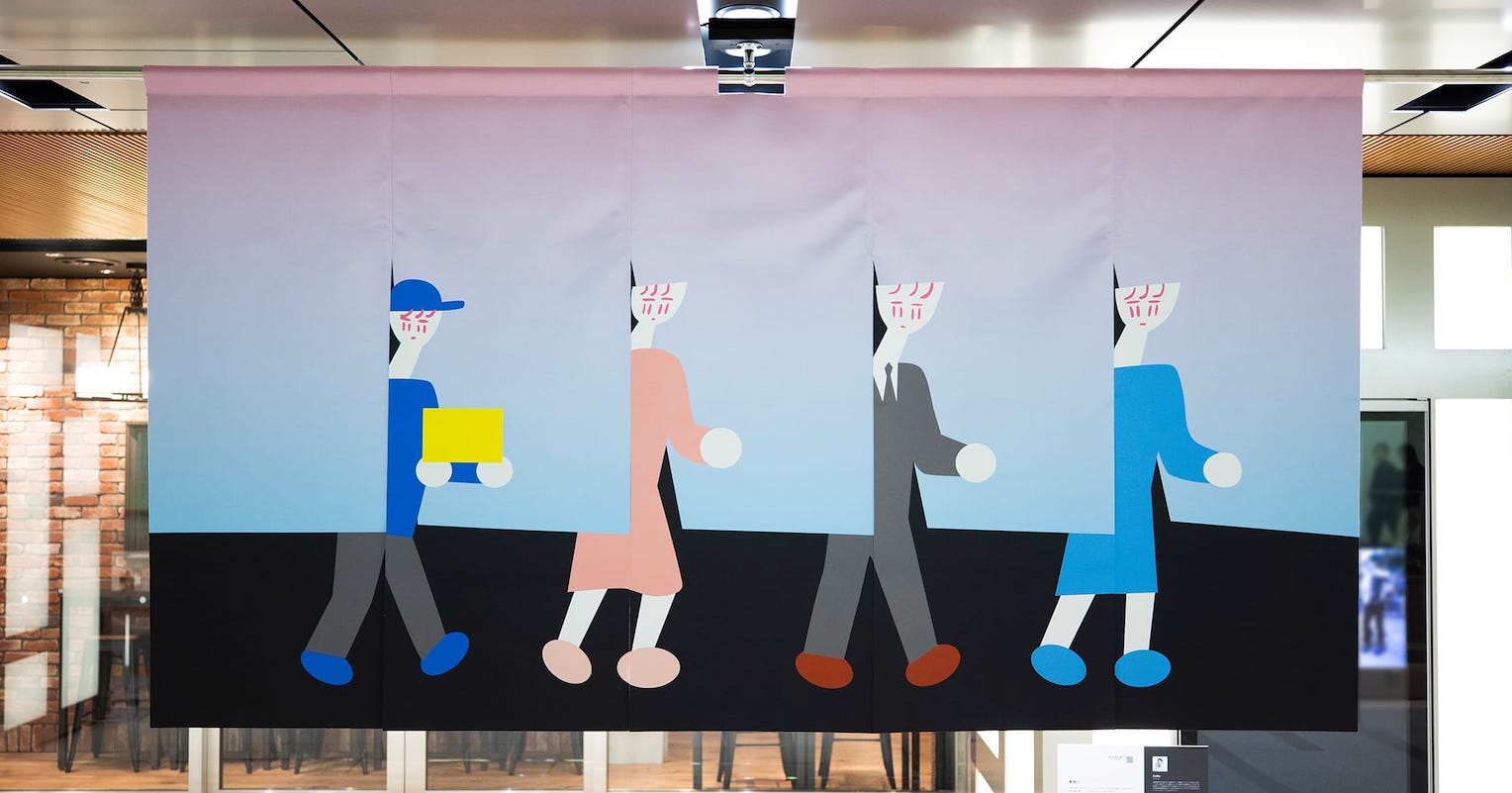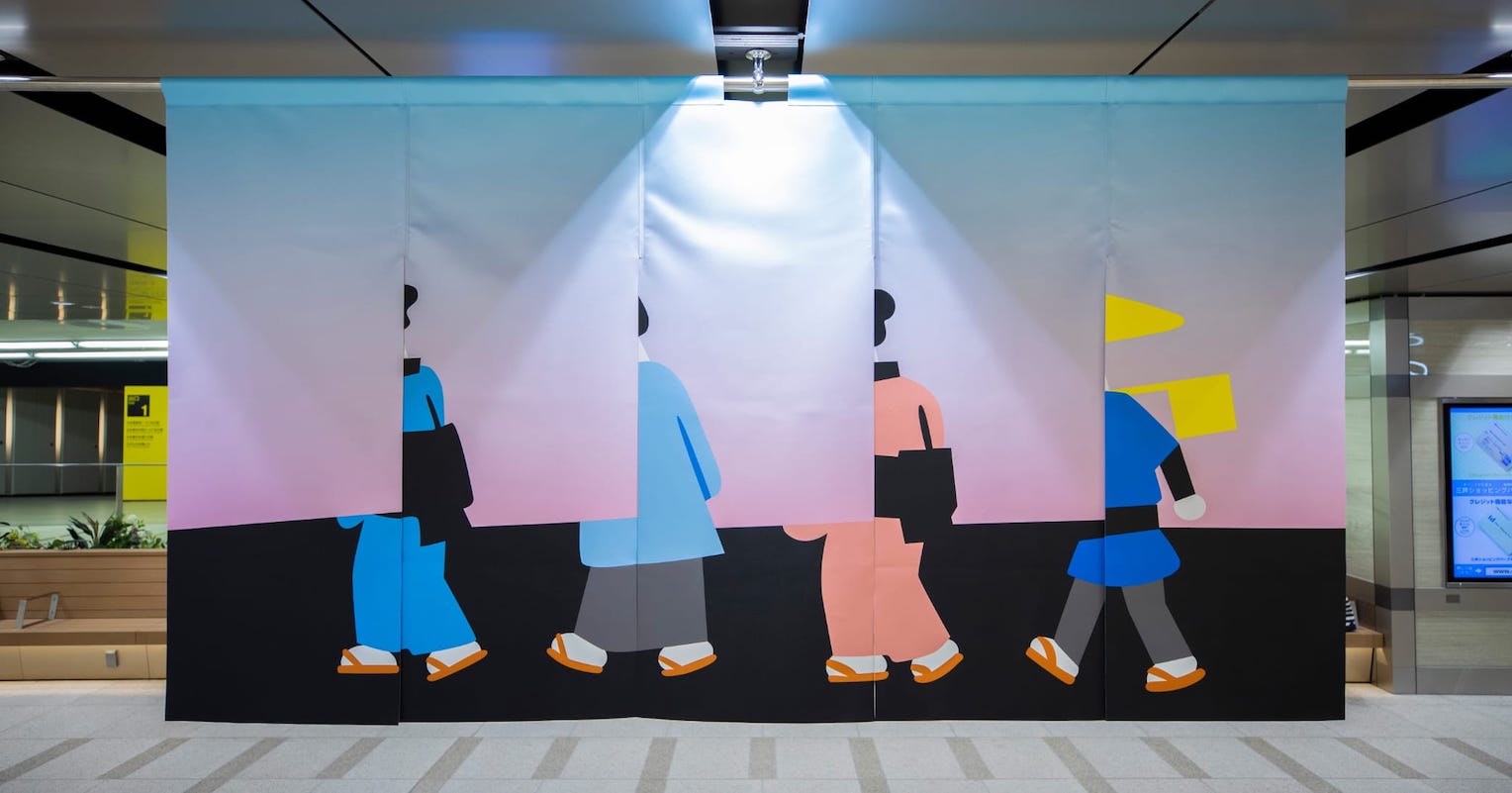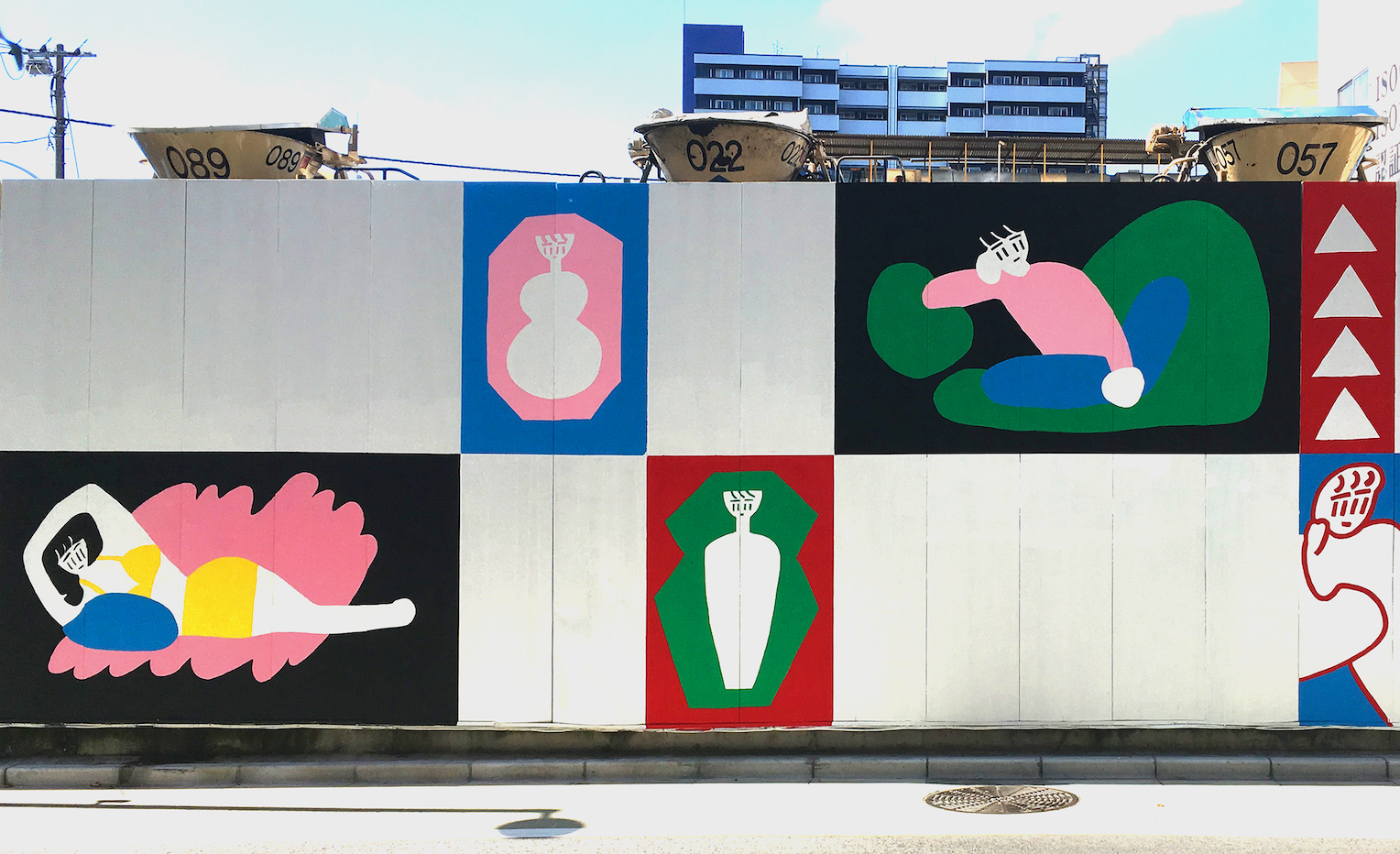Trying to find ways for expression in between graphic and space. Where visitors are to “experience Noren (traditional Japanese curtains for entrance)”
Trying to find ways for expression in between graphic and space. Where visitors are to “experience Noren (traditional Japanese curtains for entrance)”

[Meguru Noren Exhibition - Interview with Creators vol.2 Colliu]
NIHONBASHI MEGURU FES which has been taking place for about 2 months since September 27. Various creators participate in one of these events called “Meguru Noren Exhibition”, to design Noren curtinas to express the town of Nihonbashi. We have made a series of interviews with three young creators who took the challenge to make the Noren for the exhibition starting on Friday, October 11.
For the 2nd volume, we are going to interview Ms. Colliu, who is an artist as well as a model. She is working in a variety of fields including making appearances in corporate advertisements and magazines, and creating drawing and installations. We got Ms. Colliu, whose exhibition “Dear My Plinth” is now opening as a part of The 20th Future of Creation by Toshio Shimizu held at Kyobashi LIXIL Gallery, to talk about her thoughts on the Noren and how she expressed herself in the work.


Expressed the “Vibrant Town Since Olden Days” with Original Motifs.
- When you heard you were going to make a Noren curtain, what was your first impression?
The first thing that came up in my mind was that Noren is something you walk through. I wanted to make sure we are conscious about the entire space, with the people going through the Noren.
And I had the image that Noren is always something simple with colors and dyes, so I was going for that at first. But when I saw the fabric samples of the Noren, there are ways to make it colorful, and some fabrics allow both sides to have patterns... I remember they got me very excited. I ended up going with the fabric that can arrange expressions on both sides, and I wanted to work with it from the moment I saw the sample.
- The theme was “Noren to express the town of Nihonbashi”. Ms. Colliu, what were your thoughts on Nihonbashi?
I thought the town integrates the modern elements quite well, while still keeping the old history. In Nihonbashi, the traditional cutlery shop and dashi broth shop have very modern design, but they are not just newly made, I feel that you can see the reason they have been here and stories behind them. Each of them had its own long history, and experienced updates to match the society at the time. It is a town you can naturally see its history and story.
- With such image on your mind, how did you come up with the concrete design?
When I’m lacking inspirations, I always go ahead and investigate the target and surroundings of the design. By doing this, I often end up finding thoughts and motifs that would fit me.
So, I did some research on the town of Nihonbashi and Noren, and what ended up helping me the most was “Kidai Shoran (Excellent View of Our Prosperous Age, a paper scroll depicting Nihonbashi during the Edo Period).” I knew the work but looking at it again gave me lots of tips. There are a lot of Noren’s, so it has a quite high affinity with the theme of our exhibition, and it gave me a chance to get to know the impression of Nihonbashi as “town with full of working people”, which I used to incorporate into my work. And I came to think that I want to express this vibrant and bustling atmosphere that has been unchanged since long ago, using “people” for expression.
I also thought that I could bring my own little characters, which I use for my other works, to make it look more unique and original.

Unique human characters appear in the works of Ms. Colliu.
- On your Noren, there are 8 unique characters, and they make your work look very characteristic.
Since I started creation, I thought I would be able to handle different themes more flexibly if I had my own trademark. Even if the output and touch came out to be different, I would be able to establish my own style to express myself. That was also why I made the format of the characters.
- Your style is well expressed in how you use the colors.
I tried going colorful to overthrow the stereotypical idea that Noren should be simple in colors. It’s partially that I like colorful things to start with, but the background of Ukiyo-e where I ended up with my research on Nihonbashi gave me an idea to make the gradient colors. I hope the power of colors will make people feel better who see my work.

Ms. Colliu is quite familiar with the area, as her brother works in Nihonbashi, and she goes to movie theaters in Nihonbashi. “My personal exhibition is in Kyobashi while the Noren Exhibition is on, I would be very happy if you can go “gallery hopping” while walking around the town.”
Not to See but to Go Through! Noren which Visitors can “Experience”.
- Ms. Colliu, your works are full of variety, from graphic to three-dimensional objects. With your experience, is there anything you were interested in working with Noren?
Noren is a planar object, but it becomes dynamic as “going through” motion is involved, and works three-dimensional as well. I found it very interesting to design something that stands in the middle of graphic and three-dimensional. I’ve been always attracted to projects with more freedom in expression such as space creation, so I definitely enjoyed working on this.
- On the other hand, was there anything you found difficult while working on the design?
I was already determined to express the bustling Nihonbashi with people as motif, with “walk-through” gimmick, but there was a time I felt like something was missing. And it was very difficult for me to get out of there.
- How did you get over that state?
When I’m up against a problem, I always try to ask people around, so I went ahead and talked to my friend. Then I got a piece of advice, “Why don’t you try drawing different time periods on each side if you can do two-sided printing?” This objective advice triggered me to think of more concrete design. In the end, I feel like I was able to express Nihonbashi in its old days.

Ms. Colliu says she “tries to utilize planar objects into three-dimensional”. The Noren Exhibition project fit her concept well.
- The project was creation targeting the town of Nihonbashi. In a town as a setting like this, is there anything you would like to try working on in future?
I’m quite interested in public art.
So far, my creatives have been something of planar objects, but when you have an exhibition, it will always be a three-dimensional space, including an art gallery. So, I always try to think about how to utilize things I came up with in two-dimensional into three- dimensional. Recently, I have more projects with three-dimensional or spatial expression, so I am quite hooked in public art as it is like the ultimate form of such expression.
When a piece of work is placed in location where many people come and go, it becomes the landmark or a meeting point...the fact that the work is in that place makes up a character of the area, which I find very interesting.
And when you have an exhibition in a public space, the work will be viewed differently from how you originally meant it to be. The potential of something happening unintentionally by people being involved is also an interesting part of the public art.
The Noren Exhibition is out in a public space, so I am very excited about how people would react to it. There would probably be different reactions as opposed to having exhibitions in like art galleries.
- How would you want people who actually go through the Noren Exhibition space to enjoy?
I want them to walk through it! I would love if they have fun in different ways, like taking pictures with the same posing as the characters in the Noren. It is an exhibition so I would be happy if people just see my work, but I hope they have some kind of “experience” rather than just looking at it.
Interview and Article: Kei Furuta(Konel) Photos: Daisuke Okamura
Colliu
Artist and model. Graduated from College of Art and Design Musashino Art University in 2009 with a Major in Oil Painting While working as an artist in group and personal exhibitions, actively working as a model in fashion shows, corporate advertisements, and magazines. Starting on Saturday, October 12, The 20th Future of Creation by Toshio Shimizu, Colliu “Dear My Plinth” will be held at LIXIL Gallery, Kyobashi, Tokyo.




